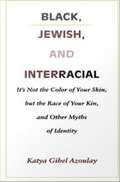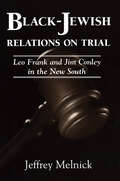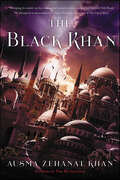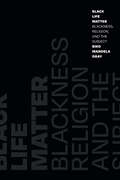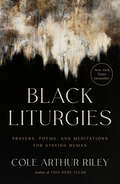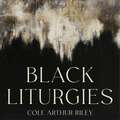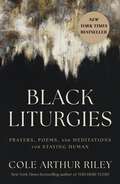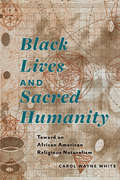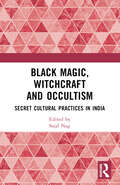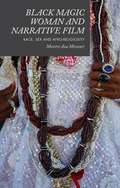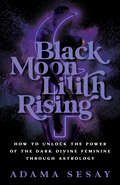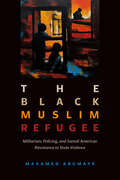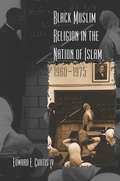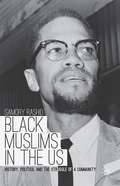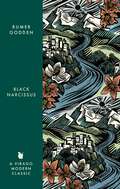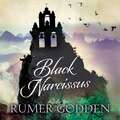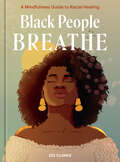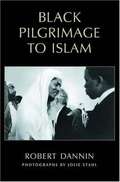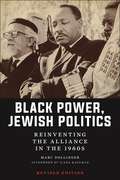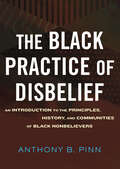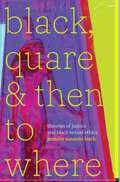- Table View
- List View
Black, Jewish, and Interracial: It's Not the Color of Your Skin, but the Race of Your Kin & Other Myths of Identity
by Katya Gibel AzoulayHow do adult children of interracial parents--where one parent is Jewish and one is Black--think about personal identity? This question is at the heart of Katya Gibel Azoulay's Black, Jewish, and Interracial. Motivated by her own experience as the child of a Jewish mother and Jamaican father, Gibel Azoulay blends historical, theoretical, and personal perspectives to explore the possibilities and meanings that arise when Black and Jewish identities merge. As she asks what it means to be Black, Jewish, and interracial, Gibel Azoulay challenges deeply ingrained assumptions about identity and moves toward a consideration of complementary racial identities. Beginning with an examination of the concept of identity as it figures in philosophical and political thought, Gibel Azoulay moves on to consider and compare the politics and traditions of the Black and Jewish experience in America. Her inquiry draws together such diverse subjects as Plessy v. Ferguson, the Leo Frank case, "passing," intermarriage, civil rights, and anti-Semitism. The paradoxical presence of being both Black and Jewish, she argues, leads questions of identity, identity politics, and diversity in a new direction as it challenges distinct notions of whiteness and blackness. Rising above familiar notions of identity crisis and cultural confrontation, she offers new insights into the discourse of race and multiculturalism as she suggests that identity can be a more encompassing concept than is usually thought. Gibel Azoulay adds her own personal history and interviews with eight other Black and Jewish individuals to reveal various ways in which interracial identities are being lived, experienced, and understood in contemporary America.
Black-Jewish Relations on Trial: Leo Frank and Jim Conley in the New South
by Jeffrey MelnickAn analysis of the Leo Frank case as a measure of the complexities characterizing the relationship between African Americans and Jews in America In 1915 Leo Frank, a northern Jew, was lynched in Georgia. He had been convicted of the murder of Mary Phagan, a young white woman who worked in the Atlanta pencil factory managed by Frank. In a tumultuous trial in 1913 Frank's main accuser was Jim Conley, an African American employee in the factory. Was Frank guilty? In our time a martyr's aura falls over Frank as a victim of religious and regional bigotry. The unending controversy has inspired debates, movies, books, songs, and theatrical productions. Among the creative works focused on the case are a ballad by Fiddlin' John Carson, David Mamet's novel The Old Religion in 1997, and Alfred Uhry and Jason Robert Brown's musical Parade in 1998. Indeed, the Frank case has become a touchstone in the history of black-Jewish cultural relations. However, for too long the trial has been oversimplified as the moment when Jews recognized their vulnerability in America and began to make common cause with African Americans. This study has a different tale to tell. It casts off old political and cultural baggage in order to assess the cultural context of Frank's trial, and to examine the stress placed on the relationship of African Americans and Jews by it. The interpretation offered here is based on deep archival research, analyses of the court records, and study of various artistic creations inspired by the case. It suggests that the case should be understood as providing conclusive early evidence of the deep mutual distrust between African Americans and Jews, a distrust that has been skillfully and cynically manipulated by powerful white people. Black-Jewish Relations on Trial is concerned less with what actually happened in the National Pencil Company factory than with how Frank's trial, conviction, and lynching have been used as an occasion to explore black-Jewish relations and the New South. Just as with the O. J. Simpson trial, the Frank trial requires that Americans make a profound examination of their essential beliefs about race, sexuality, and power.
The Black Khan: Book Two of the Khorasan Archives (The Khorasan Archives #2)
by Ausma Zehanat KhanKhan has created a rich, well-crafted world that will appeal to readers of S.A. Chakraborty’s The City of Brass (2017) or Erika Johansen’s The Queen of the Tearling -- BooklistThe second novel in Ausma Zehanat Khan’s powerful epic fantasy quartet, a series that lies "somewhere between N. K. Jemisin and George R. R. Martin" (Saladin Ahmed), in which a powerful band of women must use their magic to defeat an oppressive dark regime.To fight against the cruel and superstitious patriarchy known as the Talisman, members of the resistance group known as the Companions of Hira have risked their lives in a failed attempt to procure the Bloodprint—a dangerous text that may hold the secret to overthrowing the terrifying regime. Now, with their plans in ashes, the Companions of Hira have scattered, and the lives of two brave women at the center of the plot—Arian and Sinnia—face unprecedented danger.Yet a spark of hope flickers in the darkness—the Bloodprint has survived. It is hidden in Ashfall, the seat of Rukh, the Black Khan, whose court is ruled by intrigue and conspiracy. Treacherous enemies ruthlessly maneuver for power behind the throne, including the autocratic Grand Vizier; the deadly and secretive Assassin; the Khan’s deposed half-brother; and the commander of Ashfall’s army, who is also Rukh’s oldest friend.The Companions of Hira must somehow reunite, break through Talisman lines, and infiltrate Ashfall. A master of treachery himself, the Black Khan joins forces with these powerful women to manipulate them for his own ends. But as Ashfall comes under siege, he is forced to make a deadly calculation . . . one that could cause irrevocable damage to the Companions and their fight for freedom.
Black Life Matter: Blackness, Religion, and the Subject
by Biko Mandela GrayIn Black Life Matter, Biko Mandela Gray offers a philosophical eulogy for Aiyana Stanley-Jones, Tamir Rice, Alton Sterling, and Sandra Bland that attests to their irreducible significance in the face of unremitting police brutality. Gray employs a theoretical method he calls “sitting-with”—a philosophical practice of care that seeks to defend the dead and the living. He shows that the police who killed Stanley-Jones and Rice reduced them to their bodies in ways that turn black lives into tools that the state uses to justify its violence and existence. He outlines how Bland’s arrest and death reveal the affective resonances of blackness, and he contends that Sterling’s physical movement and speech before he was killed point to black flesh as unruly living matter that exceeds the constraints of the black body. These four black lives, Gray demonstrates, were more than the brutal violence enacted against them; they speak to a mode of life that cannot be fully captured by the brutal logics of antiblackness.
Black Liturgies: Prayers, Poems, and Meditations for Staying Human
by Cole Arthur RileyA collection of prayer, poetry, and spiritual practice centering the Black interior world, from the New York Times bestselling author of This Here Flesh and creator of Black Liturgies &“A true spiritual balm for our troubled times.&”—Michael Eric Dyson, author of What Truth Sounds LikeFor years, Cole Arthur Riley was desperate for a spirituality she could trust. Amid ongoing national racial violence, the isolation of the pandemic, and a surge of anti-Black rhetoric in many Christian spaces, she began dreaming of a more human, more liberating expression of faith. She went on to create Black Liturgies, a digital project that connects spiritual practice with Black emotion, Black memory, and the Black body.In this book, she brings together hundreds of new prayers, along with letters, poems, meditation questions, breath practices, scriptures, and the writings of Black literary ancestors to offer forty-three liturgies that can be practiced individually or as a community. Inviting readers to reflect on their shared experiences of wonder, rest, rage, and repair, and creating rituals for holidays like Lent and Juneteenth, Arthur Riley writes with a poet&’s touch and a sensitivity that has made her one of the most important spiritual voices at work today.For anyone healing from communities that were more violent than loving; for anyone who has escaped the trauma of white Christian nationalism, religious homophobia, or transphobia; for anyone asking what it means to be human in a world of both beauty and terror, Black Liturgies is a work of healing and empowerment, and a vision for what might be.
Black Liturgies: Prayers, poems and meditations for staying human
by Cole Arthur RileyIn the summer of 2020, Cole Arthur Riley was desperate for a spirituality she could trust. Amidst ongoing national racial violence, the isolation of the pandemic, and a surge of anti-Black rhetoric in many Christian spaces, she began dreaming of a harbour for a more human, more liberating expression of faith. She went on to create Black Liturgies, a digital project that connects spiritual practice with Black emotion, memory, and the Black body.In this book, she deepens the work of that project, bringing together new prayers, letters, poetry, meditation questions, breath practice, and the writings of Black literary ancestors to offer 43 liturgies that can be practised individually or as a community. With a poet's touch and a sensitivity that has made her one of the most important spiritual voices at work today, Riley invites readers to reflect on their own experiences of wonder, rest, rage, and repair, while also including liturgies for holidays like Lent, Advent and Mother's Day.For those healing from spiritual spaces that were more violent than loving; for those who have escaped the trauma of white Christian nationalism, religious homophobia, and transphobia; for anyone asking what it means to be human in a world of both beauty and terror; Black Liturgies is a work of healing and liberation, and a vision for what might be.
Black Liturgies: Prayers, poems and meditations for staying human
by Cole Arthur RileyIn the summer of 2020, Cole Arthur Riley was desperate for a spirituality she could trust. Amidst ongoing national racial violence, the isolation of the pandemic, and a surge of anti-Black rhetoric in many Christian spaces, she began dreaming of a harbour for a more human, more liberating expression of faith. She went on to create Black Liturgies, a digital project that connects spiritual practice with Black emotion, memory, and the Black body.In this book, she deepens the work of that project, bringing together new prayers, letters, poetry, meditation questions, breath practice, and the writings of Black literary ancestors to offer 43 liturgies that can be practised individually or as a community. With a poet's touch and a sensitivity that has made her one of the most important spiritual voices at work today, Riley invites readers to reflect on their own experiences of wonder, rest, rage, and repair, while also including liturgies for holidays like Lent, Advent and Mother's Day.For those healing from spiritual spaces that were more violent than loving; for those who have escaped the trauma of white Christian nationalism, religious homophobia, and transphobia; for anyone asking what it means to be human in a world of both beauty and terror; Black Liturgies is a work of healing and liberation, and a vision for what might be.
Black Lives and Sacred Humanity: Toward an African American Religious Naturalism
by Carol Wayne WhiteIdentifying African American religiosity as the ingenuity of a people constantly striving to inhabit their humanity and eke out a meaningful existence for themselves amid harrowing circumstances, Black Lives and Sacred Humanity constructs a concept of sacred humanity and grounds it in the writings of Anna Julia Cooper, W. E. B. Du Bois, and James Baldwin. Supported by current theories in science studies, critical theory, and religious naturalism, this concept, as Carol Wayne White demonstrates, offers a capacious view of humans as interconnected, social, value-laden organisms with the capacity to transform themselves and create nobler worlds wherein all sentient creatures flourish.Acknowledging the great harm wrought by divisive and problematic racial constructions in the United States, this book offers an alternative to theistic models of African American religiosity to inspire newer, conceptually compelling views of spirituality that address a classic, perennial religious question: What does it mean to be fully human and fully alive?
Black Magic, Witchcraft and Occultism: Secret Cultural Practices in India
by Sajal NagBlack magic, occult practices and witchcraft still evoke huge curiosity, interest and amazement in the minds of people. Although witchcraft in Europe has been a widely studied phenomenon, black magic and occult are not yet a popular theme of academic research, even though India is known as a land of magic, tantra and occult. The Indian State of Assam was historically feared as the land of Kamrup-Kamakhya, black magic, witchcraft and occultic practices. It was where different Tantric cults as well as other occult practices thrived. The Khasi Hills are known for the practice of snake vampire worship. The village of Mayong is the village, where magic and occult is still practiced as a living tradition. This book is one of the rarest collections where such practices are researched, recorded and academically analyzed. It is one of those collections where studies of all three practices of Black Magic, Witchcraft and Occult are comibned into one single book.
Black Magic Woman and Narrative Film: Race, Sex and Afro-Religiosity
by Montré Aza MissouriBlack Magic Woman and Narrative Film examines the transformation of the stereotypical 'tragic mulatto' from tragic to empowered, as represented in independent and mainstream cinema. The author suggests that this transformation is through the character's journey towards African-based religions.
Black Men Worshipping
by Stacy C. Boyd"Black Men Worshipping" analyzes the discursive spaces where black Christian masculinity is constructed, performed, and contested in American religion and culture. It judiciously considers the anxiety that emerges from black male negotiations with constructions of blackness, maleness, and Christian embodiment. "Black Men Worshipping" places fictive literary narratives such as "Uncle Tom's Cabin" and "In My Father's House," and film narratives such as "The Green Mile" in dialogue with the non-fictive narratives of popular African American figures Bishop T. D. Jakes and Pastor Donnie McClurkin in an effort to provide a snapshot of the complex constellation of issues involved in black male Christian embodiment.
Black Moon Lilith Rising: How to Unlock the Power of the Dark Divine Feminine Through Astrology
by Adama SesayAn exploration of the Black Moon Lilith placement in astrology—a widely searched yet underserved topic—that reclaims the misunderstood archetype of Lilith and shows you how to use her energy for empowerment and transformation.Black Moon Lilith Rising is unlike any other astrology book out there on multiple fronts: it is a comprehensive exploration of the placement of Lilith in astrology, it&’s a deep exploration into the misunderstood myth and archetype of Lilith, and it incorporates shadow work and spiritual alchemy.The book begins with an ode to Lilith, anecdotal stories surrounding the author&’s experience with the energy, the history, and mythology behind the Lilith archetype. Lilith has been demonized, known as the first rebellious, disobedient woman, but in fact she is a powerful, sovereign being. By untwisting the truth about her energy, the world can heal the suppressed feminine, balance the power dynamic, and ascend.The contents of the book contain:How Black Moon Lilith can be integrated practically for empowerment and life transformation. An in-depth astrological analysis covering Black Moon Lilith through the 12 zodiac signs and houses. Planetary and angular aspects are then layered on explaining how Lilith can affect the other energies in the birth chart in an impactful way.A guide to shadow work with Lilith and a Spiritual Alchemy practice for 13 days, as 13 is the number of the divine feminine.
Black Muslim Refugee: Militarism, Policing, and Somali American Resistance to State Violence (Critical Refugee Studies)
by Maxamed AbumayeThis multisited project, the first of its kind, exposes the links between US military violence abroad and police brutality at home through a profound exploration of Somali refugee lives. Black Muslim Refugee traces the globe-spanning journeys of these refugees, from civil war–era Somalia to the Dadaab refugee camp in Kenya to their eventual arrival in San Diego, and Maxamed Abumaye analyzes their experiences through the dual lenses of anti-Blackness and Islamophobia. He situates their displacement within the larger context of East Africa's colonial history, as well as the policy consequences of the American-backed war on terror and war on drugs. Throughout, Abumaye's centering of Somali subjectivity underlines this community's critical and creative capacity to defy the mechanisms that seek to "manage" and ultimately control them.
Black Muslim Religion in the Nation of Islam, 1960-1975
by Edward E. Curtis IVElijah Muhammad's Nation of Islam came to America's attention in the 1960s and 1970s as a radical separatist African American social and political group. But the movement was also a religious one. Edward E. Curtis IV offers the first comprehensive examination of the rituals, ethics, theologies, and religious narratives of the Nation of Islam, showing how the movement combined elements of Afro-Eurasian Islamic traditions with African American traditions to create a new form of Islamic faith.Considering everything from bean pies to religious cartoons, clothing styles to prayer rituals, Curtis explains how the practice of Islam in the movement included the disciplining and purifying of the black body, the reorientation of African American historical consciousness toward the Muslim world, an engagement with both mainstream Islamic texts and the prophecies of Elijah Muhammad, and the development of a holistic approach to political, religious, and social liberation. Curtis's analysis pushes beyond essentialist ideas about what it means to be Muslim and offers a view of the importance of local processes in identity formation and the appropriation of Islamic traditions.
Black Muslims in the US
by Samory RashidBlack Muslims in the U. S. seeks to address deficiencies in current scholarship about black Muslims in American society, from examining the origins of Islam among African-Americans to acknowledging the influential role that black Muslims play in contemporary U. S. society.
Black Narcissus
by Rumer GoddenA novel about five nuns who found a mission in India, their struggles, their failure, and their decision to abandon the project.
Black Narcissus: Now a haunting BBC drama starring Gemma Arterton (Virago Modern Classics #158)
by Rumer GoddenNOW A HAUNTING BBC DRAMA, STARRING GEMMA ARTERTON AND DIANA RIGG'Godden's wonderful book sets out a complex vision of the variety, necessity and danger of desire, rendered into a story that is completely pleasurable. I envy anyone reading it for the first time' - Amanda CoeHigh in the Himalayas, the mountaintop palace shines like a jewel. Built for the General's harem, laughter and music once floated out over the gorge. Now it sits abandoned, windswept and haunting.The palace is bestowed to the Sisters of Mary, and what was once known as 'the House of Women' becomes the Convent of St Faith. Close to the heavens, the nuns feel inspired, working fervently to establish their school and hospital. But as the isolation and emptiness of the mountain become increasingly unsettling, passions long repressed emerge with tragic consequences . . .
Black Narcissus: Now a haunting BBC drama starring Gemma Arterton (Vmc Ser. #494)
by Rumer GoddenNOW A HAUNTING BBC DRAMA, STARRING GEMMA ARTERTON AND DIANA RIGG'Godden's wonderful book sets out a complex vision of the variety, necessity and danger of desire, rendered into a story that is completely pleasurable. I envy anyone reading it for the first time' - Amanda CoeHigh in the Himalayas, the mountaintop palace shines like a jewel. Built for the General's harem, laughter and music once floated out over the gorge. Now it sits abandoned, windswept and haunting.The palace is bestowed to the Sisters of Mary, and what was once known as 'the House of Women' becomes the Convent of St Faith. Close to the heavens, the nuns feel inspired, working fervently to establish their school and hospital. But as the isolation and emptiness of the mountain become increasingly unsettling, passions long repressed emerge with tragic consequences . . .
Black Narcissus: Now a haunting BBC drama starring Gemma Arterton (Virago Modern Classics #158)
by Rumer GoddenNow a major BBC drama starring Gemma ArtertonHigh in the Himalayas near Darjeeling, the old mountaintop palace shines like a jewel. When it was the General's 'harem' palace, richly dressed ladies wandered the windswept terraces; at night, music floated out over the villages and gorges. Now, the General's son has bestowed it on an order of nuns, the Sisters of Mary.Well-intentioned yet misguided, the nuns set about taming the gardens and opening a school and dispensary for the villagers. They are dependent on the local English agent of Empire, Mr Dean; but his charm and insolent candour are disconcerting. And the implacable emptiness of the mountain, the ceaseless winds, exact a toll on the Sisters.When Mr Dean says bluntly, 'This is no place for a nunnery,' it is as if he foresees their destiny...
Black People Breathe: A Mindfulness Guide to Racial Healing
by Zee ClarkeA thoughtful, inclusive, and vividly illustrated guide to help Black people—and all people of color—heal from racial trauma using vital tools from an expert in mindfulness, meditation, and breathwork. It is your right to survive. It is your right to thrive. Mindfulness and breathwork will help you do just that. Racism is more than just an interpersonal experience. It is a systemic injustice that affects the lives of Black people, and all people of color, in countless ways. Doctors and psychologists have discovered the wide-ranging—and often devastating—effects of racism on one&’s emotional, physical, and mental health, from high blood pressure and heart problems to anxiety and depression. Yet studies show that mindfulness, meditation, and breathwork can significantly reduce these issues. This is where Zee Clarke comes in. In this powerful book, Clarke draws on her professional expertise and her lived experience as a Black woman to share mindfulness exercises, breathwork practices, and meditative tools centered on healing from and surviving racial trauma. Filled with deeply personal stories highlighting the many systemic challenges that people of color face, this mixture of guide and memoir offers thirty-three practical techniques based on the emotions elicited from these experiences. Whether you are coping with police brutality, racial profiling, microaggressions, or even imposter syndrome, Black People Breathe gives you the tools to process these complex feelings physically, mentally, and emotionally. Though this collection was created to facilitate healing for communities of color, it also offers allies insight into the discrimination and inequity that these communities face, creating a space for deeper empathy and the inspiration to drive change. Beautifully designed with gorgeous, vibrant illustrations, Black People Breathe takes a radically inclusive approach to mindfulness, allowing communities of color the opportunity to embark on a journey towards racial healing.
Black Power, Jewish Politics: Reinventing the Alliance in the 1960s, Revised Edition (Goldstein-Goren Series in American Jewish History)
by Marc DollingerHighlights Jewish participation in the civil rights movementBlack Power, Jewish Politics charts the transformation of American Jewish political culture from the Cold War liberal consensus of the early postwar years to the rise and influence of Black Power-inspired ethnic nationalism. It shows how, in a period best known for the rise of antisemitism in some parts of the Black community and the breakdown of the alliance between white Jews and Black Americans, Black Power activists enabled Jewish activists to devise a new Judeo-centered political agenda—including the emancipation of Soviet Jews, the rise of Jewish Day Schools, the revitalization of worship services with gender-inclusive liturgy, and the birth of a new form of American Zionism.Undermining widely held beliefs about the civil rights movement, Black Power, racism, Soviet Jewry, American Zionism, and the religious revival of the 1970s, Black Power, Jewish Politics describes a new political consensus based on identity politics that drew Black and Jewish Americans together and altered the course of American liberalism.In the midst of national reckoning on race, this revised edition extends the book’s thesis to the contemporary period, investigating the limits of white Jewish liberalism, the ways in which scholars have and have not addressed racial privilege in their work, and the dynamics around these themes in a much more diverse American Jewish community.
The Black Practice of Disbelief: An Introduction to the Principles, History, and Communities of Black Nonbelievers
by Anthony PinnA short introduction to Black Humanism: its history, its present, and the rich cultural sensibilities that infuse itIn the United States, to be a Black American is to be a Black Christian. And there&’s something to this assumption in that the vast majority of African Americans are Christian. However, in recent years a growing number of African Americans have said they claim no particular religious affiliation—they are Black "nones." And of these Black "nones," the most public and vocal are those who claim to be humanists.What does it mean to be a Black humanist? What do Black humanist believe, and what do they do? This slim volume answers these questions. Animated by six central principles, and discussed in terms of its history, practices, formations, and community rituals, this book argues that Black humanism can be understood as a religious movement. Pinn makes a distinction between theism and religion—which is simply a tool for examining, naming, and finding the meaning in human experience. Black humanism, based on this definition isn&’t theistic but it is a religious system used to explore human experience and foster life meaning. It infuses humanism with rich cultural sensibilities drawn from Black experience. As shown in these pages, thinking about Black humanism this way frees readers from making unfounded assumptions and enables them to better appreciate the secular &“beliefs,&” ritual structures, and community formation constituted by Black humanists.
Black Preaching: The Recovery of a Powerful Art
by Henry H. MitchellHenry H. Mitchell has completely revised and integrated his popular books The Recovery of Preaching and Black Preaching for seminarians and pastors--both Black and White--who are seeking to add power and vision to their sermons. Mitchell persuasively demonstrates that Black culture and preaching style are vital for the empowerment of Black congregations and have much to offer the preaching method of all preachers. By focusing on the use of storytelling, imagination, and style of preaching rooted in African-American culture, Mitchell spotlights effective techniques for lively preaching.
Black, Quare, and Then to Where: Theories of Justice and Black Sexual Ethics (Religious Cultures of African and African Diaspora People)
by jennifer susanne leathIn Black, Quare, and Then to Where jennifer susanne leath explores the relationship between Afrodiasporic theories of justice and Black sexual ethics through a womanist engagement with Maât the ancient Egyptian deity of justice and truth. Maât took into account the historical and cultural context of each human’s life, thus encompassing nuances of politics, race, gender, and sexuality. Arguing that Maât should serve as a foundation for reconfiguring Black sexual ethics, leath applies ancient Egyptian moral codes to quare ethics of the erotic, expanding what relationships and democratic practices might look like from a contemporary Maâtian perspective. She also draws on Pan-Africanism and examines the work of Alice Walker, E. Patrick Johnson, Cheikh Anta Diop, Sylvia Wynter, Sun Ra, and others. She shows that together these thinkers and traditions inform and expand the possibilities of Maâtian justice with respect to Black sexual experiences. As a moral force, leath contends, Maât opens new possibilities for mapping ethical frameworks to understand, redefine, and imagine justices in the United States.
